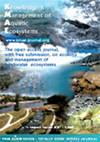巨骨舌鱼的保护悖论(Schinz, 1822)(双鱼座:巨骨舌鱼科):巴西本土濒临灭绝,印度尼西亚入侵
IF 1.7
3区 环境科学与生态学
Q3 FISHERIES
引用次数: 17
摘要
众所周知,观赏水产养殖是非本土物种的主要来源之一,印度尼西亚已被确定为世界上这些生物的主要供应国之一。释放或逃逸的观赏水生动物可以建立新的种群并成为入侵物种。另一方面,一些入侵物种也可能在其本土范围内濒临灭绝,这被称为“生物多样性保护悖论”。对于巨骨舌鱼来说就是如此,巨骨舌鱼是一种受欢迎的观赏生物,也是最大的硬骨鱼,在亚马逊河部分地区的原生范围受到威胁,在印度尼西亚爪哇和苏门答腊岛的许多地方都发现了它的存在。根据气候匹配,我们发现印度尼西亚的绝大部分领土都适合这个物种的建立。考虑到A. gigas的大小和捕食行为,我们讨论了其传播的可能后果及其对印度尼西亚本地生物群的影响。本文章由计算机程序翻译,如有差异,请以英文原文为准。
Conservation paradox of giant arapaima Arapaima gigas (Schinz, 1822) (Pisces: Arapaimidae): endangered in its native range in Brazil and invasive in Indonesia
Ornamental aquaculture is known to be one of the main sources of non-native species and Indonesia has been identified as one of the leading suppliers of these organisms worldwide. Released or escaped ornamental aquatic animals can establish new populations and become invasive. On the other hand, some invasive species can be also endangered in their native range, which is called the “Biodiversity Conservation Paradox”. This is true for Arapaima gigas, one of the popular ornamental creatures and the largest bony fish of all, which is threatened in its native range in parts of Amazonia and which has been found to occur in various localities in Java and Sumatra in Indonesia. Based on climate matching we found the vast majority of Indonesian territory to be suitable for this species establishment. Keeping in mind the size and predatory behaviour of A. gigas, we discussed possible consequences of its spread and impacts on native biota in Indonesia.
求助全文
通过发布文献求助,成功后即可免费获取论文全文。
去求助
来源期刊

Knowledge and Management of Aquatic Ecosystems
环境科学-海洋与淡水生物学
CiteScore
3.70
自引率
5.60%
发文量
22
审稿时长
>12 weeks
期刊介绍:
Knowledge and Management of Aquatic Ecosystems (KMAE-Bulletin Français de la Pêche et de la Pisciculture since 1928) serves as a foundation for scientific advice across the broad spectrum of management and conservation issues related to freshwater ecosystems.
The journal publishes articles, short communications, reviews, comments and replies that contribute to a scientific understanding of freshwater ecosystems and the impact of human activities upon these systems. Its scope includes economic, social, and public administration studies, in so far as they are directly concerned with the management of freshwater ecosystems (e.g. European Water Framework Directive, USA Clean Water Act, Canadian Water Quality Guidelines, …) and prove of general interest to freshwater specialists. Papers on insular freshwater ecosystems and on transitional waters are welcome. KMAE is not a preferred journal for taxonomical, physiological, biological, toxicological studies, unless a clear link to ecological aspects can be established. Articles with a very descriptive content can be accepted if they are part of a broader ecological context.
 求助内容:
求助内容: 应助结果提醒方式:
应助结果提醒方式:


